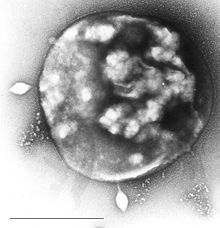Sulfolobus
| Sulfolobus | |
|---|---|
 |
|
| Electron micrograph of Sulfolobus infected with Sulfolobus virus STSV1. Bar = 1 μm. | |
| Scientific classification | |
| Domain: | Archaea |
| Kingdom: | Crenarchaeota |
| Phylum: | Crenarchaeota |
| Class: | Thermoprotei |
| Order: | Sulfolobales |
| Family: | Sulfolobaceae |
| Genus: |
Sulfolobus Brock, Brock, Belly & Weiss, 1972 |
| Species | |
|
|
Sulfolobus is a genus of microorganism in the family Sulfolobaceae. It belongs to the archaea domain.
Sulfolobus species grow in volcanic springs with optimal growth occurring at pH 2-3 and temperatures of 75-80 °C, making them acidophiles and thermophiles respectively. Sulfolobus cells are irregularly shaped and flagellar.
Species of Sulfolobus are generally named after the location from which they were first isolated, e.g. Sulfolobus solfataricus was first isolated in the Solfatara volcano. Other species can be found throughout the world in areas of volcanic or geothermal activity, such as geological formations called mud pots, which are also known as solfatare (plural of solfatara).
When the first Archaeal genome, Methanococcus jannaschii, had been sequenced completely in 1996, it was found that the genes in the genome of Methanococcus jannaschii involved in DNA replication, transcription, and translation were more related to their counterparts in eukaryotes than to those in other prokaryotes. In 2001, the first genome sequence of Sulfolobus, Sulfolobus solfataricus P2, was published. In P2's genome, the genes related to chromosome replication were likewise found to be more related to those in eukaryotes. These genes include DNA polymerase, primase (including two subunits), MCM, CDC6/ORC1, RPA, RPC, and PCNA. In 2004, the origins of DNA replication of Sulfolobus solfataricus and Sulfolobus acidocaldarius were identified. It showed that both species contained two origins in their genome. This was the first time that more than a single origin of DNA replication had been shown to be used in a prokaryotic cell. The mechanism of DNA replication in archaea is evolutionary conserved, and similar to that of eukaryotes. Sulfolobus is now used as a model to study the molecular mechanisms of DNA replication in Archaea. And because the system of DNA replication in Archaea is much simpler than that in Eukaryota, it was suggested that Archaea could be used as a model to study the much more complex DNA replication in Eukaryota.
...
Wikipedia
